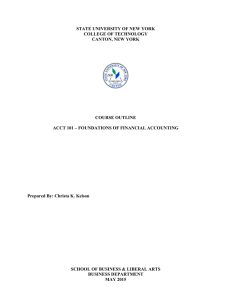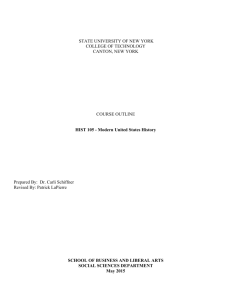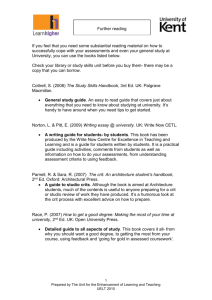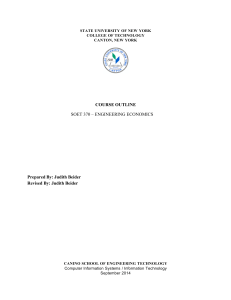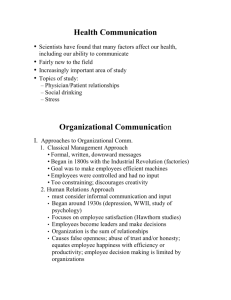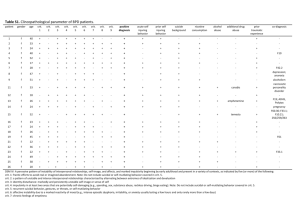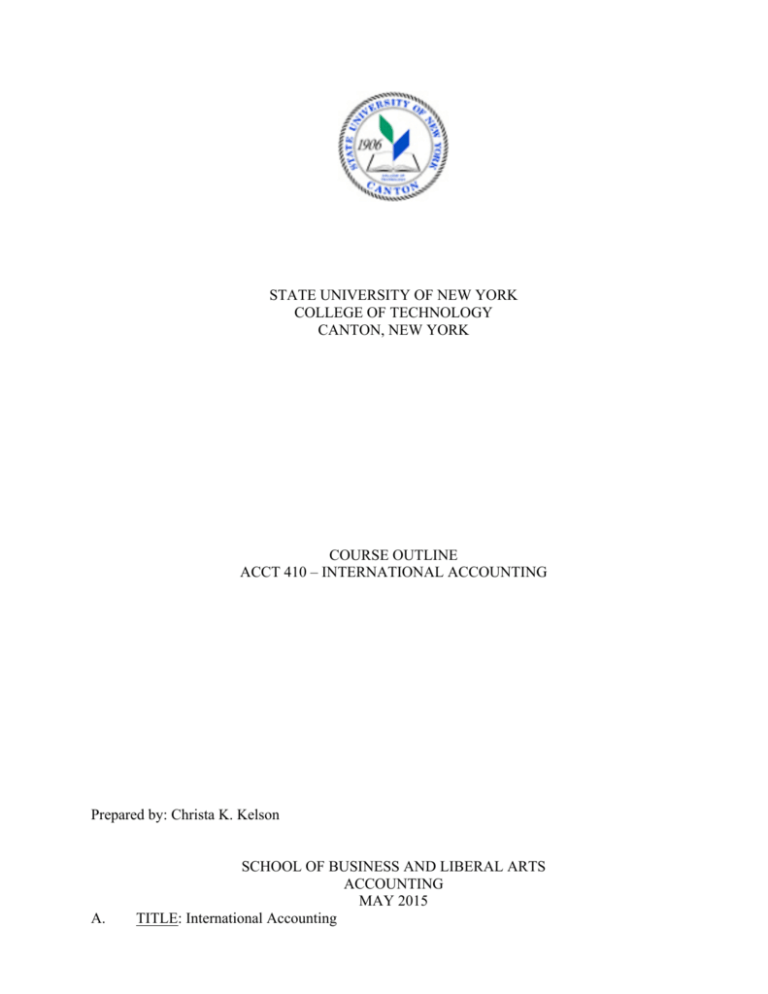
STATE UNIVERSITY OF NEW YORK
COLLEGE OF TECHNOLOGY
CANTON, NEW YORK
COURSE OUTLINE
ACCT 410 – INTERNATIONAL ACCOUNTING
Prepared by: Christa K. Kelson
A.
SCHOOL OF BUSINESS AND LIBERAL ARTS
ACCOUNTING
MAY 2015
TITLE: International Accounting
B.
COURSE NUMBER: ACCT 410
C.
CREDIT HOURS: 3
D.
WRITING INTENSIVE COURSE: No
E.
COURSE LENGTH: 15 weeks
F.
SEMESTER(S) OFFERED: Fall/Spring
G.
HOURS OF INTERNSHIP; LECTURE; SEMINAR ACTIVITY: 3 lecture hours per week.
H.
CATALOG DESCRIPTION: International Accounting is the study of an entity reported as
either a multinational company or an entity whose reporting obligations to stakeholders are
located in a country other than that of the reporting entity. A detailed investigation on the
convergence of U.S. Generally Accepted Accounting Principles (GAAP) and International
Financial Reporting Standards (IFRS) serves as a foundation for this course. Also discussed
are the effects of financial reporting, international taxation, and international financial
statement analysis on a multinational reporting entity. Employing and critiquing the use of
global accounting and auditing standards will integrate the student’s existing skills with
domestic accounting standards.
I.
PRE-REQUISITES/CO-COURSES: ACCT 102, or permission of instructor.
J.
STUDENT LEARNING OUTCOMES: Upon completion of this course, the
student will be able to:
Course Objective
a. Explain how international accounting
differs from domestic (U.S.) accounting.
b. Appreciate the historical development of
international accounting.
c. Identify several internal and external
reporting issues that arise when business
operations navigate national borders.
d. Explain the difference between ‘fair
presentation’ and ‘legal compliance’ under
the discipline of accounting and relate said
concepts to corresponding countries.
e. Compare and contrast financial accounting
systems for five of the highly developed
economies of the Eurpoeon Union (EU).
f. Relate International Reporting Standards
(IFRS) to U.S. Generally Accepted
Accounting Principles (GAAP).
Institutional SLO
1. Comm. Skills
2. Crit. Thinking
3. Prof. Competence
1. Comm. Skills
2. Crit. Thinking
3. Prof. Competence
1. Comm. Skills
2. Crit. Thinking
3. Prof. Competence
1. Comm. Skills
2. Crit. Thinking
3. Prof. Competence
4. Inter-Intra Skills
1. Comm. Skills
2. Crit. Thinking
3. Prof. Competence
1. Comm. Skills
2. Crit. Thinking
3. Prof. Competence
4. Inter-Intra Skills
g. Calculate international financial statement
analysis for a multinational reporting
entity.
h. Discriminate global accounting and
auditing standards with that of domestic
standards.
1. Comm. Skills
2. Crit. Thinking
3. Prof. Competence
4. Inter-Intra Skills
1. Comm. Skills
2. Crit. Thinking
3. Prof. Competence
4. Inter-Intra Skills
K.
TEXTBOOK: Choi, F., Meek, G. (2008) International Accounting, Pearson Prentice Hall.
8th Edition.
Plumlee, M. (2010) International Financial Reporting Standards, Prentice Hall. ISBN 978-0-13612304.
L.
REFERENCES: http://www.imanet.org/ Institute of Management Accountants,
www.ifac.org International Federation of Accountants, International Accounting Standards Board
and International Financial Reporting Standards website www.ifrs.org.
M.
EQUIPMENT: Technology enhanced classroom and access to the Internet. Glo-Bus
Strategy Simulation (software).
N.
GRADING METHOD: A-F
O.
MEASUREMENT CRITERIA: Assignments, quizzes, case studies, and exams.
P.
DETAILED COURSE OUTLINE:
I.
Introduction to International Accounting
A.
Historical development of International Accounting
B.
The global marketplace
C.
Internationalization of capital markets
II.
Development and Classification
A.
Development of accounting systems
a. Sources of Finance
b. Legal System
c. Taxation
d. Political and Economic ties
e. Inflation
f. Economic Development
g. Educational level
h. Culture
B.
Accounting values and Culture
C.
Classification
a. Four approaches
III.
Comparative Accounting
A.
a.
b.
c.
B.
a.
European Union and IFRS
IFRS requirements by country
Accounting measurements
Five national accounting systems
The Americas and Asia
Five national accounting systems
IV.
Reporting and Disclosure
A.
Development & Disclosure
a. Voluntary vs. Regulatory
B.
Reporting & Disclosure Practices
a. Forward looking
b. Social responsibility reporting
c. Internet Business Reporting & Disclosure
V.
Foreign Currency Translation
A.
Results of Operations
B.
Reasons for Translation
C.
History and Terminology
D.
Effects on Financial statements
E.
Measurement issues
F.
Impact on International Accounting Standard No. 21 and FAS 52
VI.
Financial Reporting and Changing Prices
A.
Define Changing prices
B.
Impact on Financial Statements
C.
Adjustments
a. Types of adjustments
b. Price-level adjustments
c. Current-cost adjustments
D.
National Perspectives on Inflation Accounting
E.
International Accounting Standards Board
VII.
Global Accounting and Auditing Standards
A.
International convergence
B.
History of International Accounting
C.
International Accounting Organizations
D.
EU
VIII.
International Financial Statement Analysis
A.
Challenges and opportunities
B.
Statement analysis
C.
Auditing of statements
IIX.
International Taxation & Taxation Pricing
A.
National Tax Systems
B.
Foreign source income
C.
Tax Planning
D.
E.
F.
International Transfer Pricing
Potential pitfalls
Transfer Pricing methods/best practices
IX.
Managerial Planning & Control
A.
Master Budget
B.
Capital Budget
C.
Measuring returns
D.
Multinational cost of capital
E.
Strategic costing
F.
Performance evaluation and standards
Q.
LABORATORY OUTLINE: N/A

